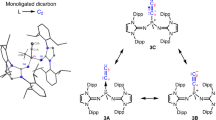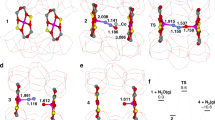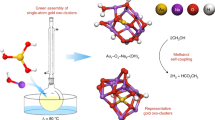Abstract
The σ-alkane complexes of transition metals, which contain an essentially intact alkane molecule weakly bound to the metal, have been well established as crucial intermediates in the activation of the strong C–H σ-bonds found in alkanes. Methane, the simplest alkane, binds even more weakly than larger alkanes. Here we report an example of a long-lived methane complex formed by directly binding methane as an incoming ligand to a reactive organometallic complex. Photo-ejection of carbon monoxide from a cationic osmium–carbonyl complex dissolved in an inert hydrofluorocarbon solvent saturated with methane at −90 °C affords an osmium(II) complex, [η5-CpOs(CO)2(CH4)]+, containing methane bound to the metal centre. Nuclear magnetic resonance (NMR) spectroscopy confirms the identity of the σ-methane complex and shows that the four protons of the metal-bound methane are in rapid exchange with each other. The methane ligand has a characteristically shielded 1H NMR resonance (δ –2.16), and the highly shielded carbon resonance (δ –56.3) shows coupling to the four attached protons (1JC–H = 127 Hz). The methane complex has an effective half-life of about 13 hours at –90 °C.

This is a preview of subscription content, access via your institution
Access options
Access Nature and 54 other Nature Portfolio journals
Get Nature+, our best-value online-access subscription
$29.99 / 30 days
cancel any time
Subscribe to this journal
Receive 12 print issues and online access
$259.00 per year
only $21.58 per issue
Buy this article
- Purchase on Springer Link
- Instant access to full article PDF
Prices may be subject to local taxes which are calculated during checkout






Similar content being viewed by others
Data availability
The authors declare that the data supporting the findings of this study are available within the paper and its Supplementary Information files.
References
IEA. Methane Tracker 2021 https://www.iea.org/reports/methane-tracker-2021 (2021).
Durrani, J. Homogeneous C–H activation. Chemistry World https://www.chemistryworld.com/holy-grails/the-grails/c-h-bond-activation (2020).
Labinger, J. A. & Bercaw, J. E. Understanding and exploiting C–H bond activation. Nature 417, 507–514 (2002).
Brookhart, M., Green, M. L. H. & Parkin, G. Agostic interactions in transition metal compounds. Proc. Natl Acad. Sci. USA 104, 6908–6914 (2007).
McGrady, G. S. & Guilera, G. The multifarious world of transition metal hydrides. Chem. Soc. Rev. 32, 383–392 (2003).
Young, R. D. Characterisation of alkane σ-complexes. Chem. Eur. J. 20, 12704–12718 (2014).
Boyd, T. M. et al. A structurally characterized cobalt(I) σ‐alkane complex. Angew. Chem. Int. Ed. 59, 6177–6181 (2020).
Chadwick, F. M. et al. Selective C–H activation at a molecular rhodium sigma-alkane complex by solid/gas single-crystal to single-crystal H/D exchange. J. Am. Chem. Soc. 138, 13369–13378 (2016).
Walter, M. D., White, P. S., Schauer, C. K. & Brookhart, M. The quest for stable σ-methane complexes: computational and experimental studies. New J. Chem. 35, 2884–2893 (2011).
Cowan, A. J. et al. Time-resolved infrared (TRIR) study on the formation and reactivity of organometallic methane and ethane complexes in room temperature solution. Proc. Natl Acad. Sci. USA 104, 6933–6938 (2007).
Perutz, R. N. & Turner, J. J. Photochemistry of the group 6 hexacarbonyls in low-temperature matrices. III. Interaction of the pentacarbonyls with noble gases and other matrices. J. Am. Chem. Soc. 97, 4791–4800 (1975).
Turner, J. J., Burdett, J. K. & Poliakoff, M. Matrix photochemistry of metal carbonyls. Pure Appl. Chem. 49, 271–285 (1977).
Bernskoetter, W. H., Schauer, C. K., Goldberg, K. I. & Brookhart, M. Characterization of a rhodium(I) σ-methane complex in solution. Science 326, 553–556 (2009).
Gonzalez, M. I. et al. Structural characterization of framework–gas interactions in the metal–organic framework Co2(dobdc) by in situ single-crystal X-ray diffraction. Chem. Sci. 8, 4387–4398 (2017).
Martin, R., Kim, M., Asthagiri, A. & Weaver, J. F. Alkane activation and oxidation on late-transition-metal oxides: challenges and opportunities. ACS Catal. 8, 4682–4703 (2021).
Khaliullin, R. Z., Cobar, E. A., Lochan, R. C., Bell, A. T. & Head-Gordon, M. Unravelling the origin of intermolecular interactions using absolutely localized molecular orbitals. J. Phys. Chem. A 111, 8753–8765 (2007).
Sun, X.-Z., Grills, D. C., Nikiforov, S. M., Poliakoff, M. & George, M. W. Remarkable stability of (η5-C5H5)Re(CO)2L (L = n-Heptane, Xe, and Kr): a time-resolved infrared spectroscopic study of (η5-C5H5)Re(CO)3 in conventional and supercritical fluid solution. J. Am. Chem. Soc. 119, 7521–7525 (1997).
Geftakis, S. & Ball, G. E. Direct observation of a transition metal alkane complex, CpRe(CO)2(cyclopentane), using NMR spectroscopy. J. Am. Chem. Soc. 120, 9953–9954 (1998).
Yau, H. M. et al. Observation of cationic transition metal-alkane complexes with moderate stability in hydrofluorocarbon solution. J. Am. Chem. Soc. 138, 281–288 (2016).
Thiele, C. M. & Bermel, W. Speeding up the measurement of one-bond scalar (1J) and residual dipolar couplings (1D) by using non-uniform sampling (NUS). J. Magn. Reson. 216, 134–143 (2012).
Takayama, Y., Sahu, D. & Iwahara, J. Observing in-phase single-quantum 15N multiplets for NH2/NH3+ groups with two-dimensional heteronuclear correlation spectroscopy. J. Magn. Reson. 194, 313–316 (2008).
Kaiser, R. Use of the nuclear Overhauser effect in the analysis of high-resolution nuclear magnetic resonance spectra. J. Chem. Phys. 39, 2435–2442 (1963).
Kennewell, P. D. Applications of the nuclear Overhauser effect in organic chemistry. J. Chem. Educ. 47, 278–280 (1970).
Chan, B. & Ball, G. E. A benchmark ab initio and DFT study of the structure and binding of methane in the σ-alkane complex CpRe(CO)2(CH4). J. Chem. Theory Comput. 9, 2199–2208 (2013).
Crabtree, R. H. Aspects of methane chemistry. Chem. Rev. 95, 987–1007 (1995).
Hall, C. & Perutz, R. N. Transition metal alkane complexes. Chem. Rev. 96, 3125–3146 (1996).
Bernskoetter, W. H. et al. Investigations of iridium-mediated reversible C–H bond cleavage: characterization of a 16-electron iridium(III) methyl hydride complex. J. Am. Chem. Soc. 131, 8603–8613 (2009).
Cowan, A. J. & George, M. W. Formation and reactivity of organometallic alkane complexes. Coord. Chem. Rev. 252, 2504–2511 (2008).
Childs, G. I., Grills, D. C., Sun, X. Z. & George, M. W. in Pure and Applied Chemistry Vol. 73, 443–447 (Walter de Gruyter, 2001).
Cobar, E. A., Khaliullin, R. Z., Bergman, R. G. & Head-Gordon, M. Theoretical study of the rhenium–alkane interaction in transition metal–alkane sigma-complexes. Proc. Natl Acad. Sci. USA 104, 6963–6968 (2007).
Lu, Q., Neese, F. & Bistoni, G. London dispersion effects in the coordination and activation of alkanes in σ-complexes: a local energy decomposition study. Phys. Chem. Chem. Phys. 21, 11569–11577 (2019).
Bellachioma, G., Cardaci, G., Macchioni, A. & Zuccaccia, C. Preparation of methyl hydride and dimethyl complexes of osmium and iron: reaction of M(CO)2(PMe3)2CH3I and [M(CO)3(PMe3)2CH3]+[BPh4]− (M = Os, Fe) with borohydrides and lithium methyl. J. Organomet. Chem. 628, 255–261 (2001).
Jones, W. D. & Maguire, J. A. The activation of methane by rhenium. Catalytic H/D exchange in alkanes with CpRe(PPh3)2H2. Organometallics. 5, 590–591 (1986).
Field, L. D., George, A. V. & Messerle, B. A. Methane activation by an iron phosphine complex in liquid xenon solution. J. Chem. Soc. Chem. Commun. 1991, 1339–1341 (1991).
Kiel, W. A., Ball, R. G. & Graham, W. A. G. Carbonyl-η-hexamethylbenzene complexes of osmium. Carbon-hydrogen activation by (η-C6Me6)Os(CO)(H)2. J. Organomet. Chem. 383, 481–496 (1990).
Gross, C. L. & Girolami, G. S. Metal-alkane complexes. Rapid exchange of hydrogen atoms between hydride and methyl ligands in [(C5Me5)Os(dmpm)(CH3)H+]. J. Am. Chem. Soc. 120, 6605–6606 (1998).
Herrmann, W. A., Herdtweck, E. & Schäfer, A. Metallcarbonyl-synthesen, I. X. X. Osmium-komplexe der carbonyl-reihe. Chem. Ber. 121, 1907–1911 (1988).
Krossing, I., Brands, H., Feuerhake, R. & Koenig, S. New reagents to introduce weakly coordinating anions of type Al(ORF)4−: synthesis, structure and characterization of Cs and trityl salts. J. Fluor. Chem. 112, 83–90 (2001).
Hoyano, J. K., May, C. J. & Graham, W. A. G. Cyclopentadienylosmium and (pentamethylcyclopentadienyl)osmium compounds. Synthesis and reactions of (η5-C5H5)Os(CO)2H, (η5-C5Me5)Os(CO)2H, and some of their derivatives. Inorg. Chem. 21, 3095–3099 (1982).
Frisch, M. J. et al. Gaussian 16 revision C01 (Gaussian, 2016).
Yu, H. S., He, X., Li, S. L. & Truhlar, D. G. MN15: a Kohn–Sham global-hybrid exchange–correlation density functional with broad accuracy for multi-reference and single-reference systems and noncovalent interactions. Chem. Sci. 7, 5032–5051 (2016).
Weigend, F. & Ahlrichs, R. Balanced basis sets of split valence, triple zeta valence and quadruple zeta valence quality for H to Rn: design and assessment of accuracy. Phys. Chem. Chem. Phys. 7, 3297–3305 (2005).
Guo, Y., Riplinger, C., Becker, U., Liakos, D. G., Minenkov, Y., Cavallo, L. & Neese, F. An improved linear scaling perturbative triples correction for the domain based local pair-natural orbital based singles and doubles coupled cluster method [DLPNO-CCSD(T)]. J. Chem. Phys. 148, 011101 (2018)..
Ribeiro, R. F., Marenich, A. V., Cramer, C. J. & Truhlar, D. G. Use of solution-phase vibrational frequencies in continuum models for the free energy of solvation. J. Phys. Chem. B 115, 14556–14562 (2011).
Becke, A. D. Density-functional thermochemistry. III. The role of exact exchange. J. Chem. Phys. 98, 5648–5652 (1993).
Perdew, J. P. & Wang, Y. Accurate and simple analytic representation of the electron-gas correlation energy. Phys. Rev. B 45, 13244–13249 (1992).
Grimme, S., Ehrlich, S. & Goerigk, L. Effect of the damping function in dispersion corrected density functional theory. J. Comput. Chem. 32, 1456–1465 (2011).
Chai, J.-D. & Head-Gordon, M. Long-range corrected hybrid density functionals with damped atom–atom dispersion corrections. Phys. Chem. Chem. Phys. 10, 6615–6620 (2008).
Neese, F. Software update: the ORCA program system, version 4.0. Comput. Mol. Sci. WIREs 8, e1327 (2018).
Glendening, E. D., Reed, A. E., Carpenter, J. E. & Weinhold, F. NBO v.3.1 (2016).
Lu, T. & Chen, F. Multiwfn: a multifunctional wavefunction analyzer. J. Comput. Chem. 33, 580–592 (2012).
te Velde, G. et al. Chemistry with ADF. J. Comput. Chem. 22, 931–967 (2001).
Adamo, C. & Barone, V. Toward reliable density functional methods without adjustable parameters: the PBE0 model. J. Chem. Phys. 110, 6158–6170 (1999).
Autschbach, J. Erratum: two-component relativistic hybrid density functional computations of nuclear spin-spin coupling tensors using Slater-type basis sets and density-fitting techniques. J. Chem. Phys. 130, 209901 (2009).
Autschbach, J. Two-component relativistic hybrid density functional computations of nuclear spin-spin coupling tensors using Slater-type basis sets and density-fitting techniques. J. Chem. Phys. 129, 094105 (2008).
Macrae, C. F. et al. Mercury 4.0: from visualization to analysis, design and prediction. J. Appl. Crystallogr. 53, 226–235 (2020).
Acknowledgements
This research was supported (partially or fully) by the Australian Government (1) through the Australian Research Council’s Discovery Projects funding scheme (project DP170104301) and (2) with the assistance of resources and services from the National Computational Infrastructure. This research includes computations using the computational cluster Katana supported by Research Technology Services at University of New South Wales Sydney. We acknowledge the technical expertise and assistance of J. Richards in the Science/Engineering workshop at University of New South Wales for modifying and constructing a bespoke NMR tube cap to enable sample preparation and irradiation at low temperature under rigorous inert atmosphere conditions.
Author information
Authors and Affiliations
Contributions
J.D.W., L.D.F. and G.E.B. designed the study and wrote the manuscript; J.D.W. and G.E.B. performed the experiments; and J.D.W., L.D.F. and G.E.B. processed and analysed the data.
Corresponding author
Ethics declarations
Competing interests
The authors declare no competing interests.
Peer review
Peer review information
Nature Chemistry thanks Maria Jose Calhorda and the other, anonymous, reviewer(s) for their contribution to the peer review of this work.
Additional information
Publisher’s note Springer Nature remains neutral with regard to jurisdictional claims in published maps and institutional affiliations.
Supplementary information
Supplementary Information
Supplementary Figs. 1–16, Tables 1–6, Discussion and references.
Supplementary Data 1
Data for graphs in Supplementary Figs. 12 and 13.
Supplementary Data 2
Text file containing coordinates of all calculated structures in xyz format (viewable with common software such as Mercury).
Rights and permissions
About this article
Cite this article
Watson, J.D., Field, L.D. & Ball, G.E. Binding methane to a metal centre. Nat. Chem. 14, 801–804 (2022). https://doi.org/10.1038/s41557-022-00929-w
Received:
Accepted:
Published:
Issue Date:
DOI: https://doi.org/10.1038/s41557-022-00929-w



